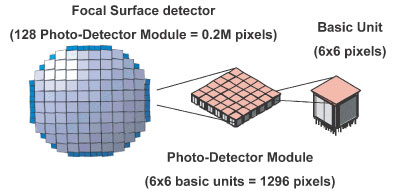
Figure 1-1: The JEM-EUSO Telescope
EUSO instrument is divided into four parts; those are optics, focal surface detector, electronics, and structure. Optics focuses the UV lights (330nm-400nm) incident to the front lens onto the focal surface with the angular resolution of 0.1 degree. The Focal Surface detector converts the energy of a photon to an electric pulse with the duration of 10 ns. The electronics counts-up the number of the electric pulses in the period of 2.5 µs and records them according to the brightness of a pixel. When it finds a signal pattern coming from EAS, it issues a trigger signal. It starts a sequence to send all the brightness data close to the triggered pixels stored in memory to the ground operation center. Structure encloses all the parts of the instruments and keeps them out from the outer harmful environment in space. It also keeps the lenses and focal surface to the preset place.
A double Fresnel lens module with 2.5m external diameters is the baseline optics for the JEM-EUSO Telescope, which observes the 330nm - 400nm optical bandwidth. Fresnel lenses (made of radiation hard light-weight plastic material) can provide a large-aperture, wide Field of View (FoV) system with reduced mass and low absorption (Figure 1-1).

Figure 1-1: The JEM-EUSO Telescope
Its telescope has a full angle FoV of 60° and a 6 arcmin (=0.1°) angular resolution. This resolution corresponds approximately to (0.75 - 0.87) km on earth, depending on the ISS altitude.
The focal surface of JEM-EUSO has a curved surface of about 2.5m in diameter, and it is covered with about 6,000 multi-anode photomultiplier tubes (Hamamatsu R8900-M36: MAPMT). The focal surface detector consists of Photo-Detector Modules (PDMs), each of which consists of 9 Elementary Cells (ECs). The EC contains 4 units of MAPMTs. Therefore, about 1,500 ECs or about 160 PDMs are arranged on the whole focal surface (Figure. 1-2).

Figure 1-2: Focal surface detector and structure
One unit of high voltage power supply for the MAPMT is set on every PDM. The photomultiplier gain is 106. The output pulse signals of the MAPMT are sent to ASICs (Application Specific Integrated Circuit) which are included in the front-end electronic circuits.
The electronic system of JEM-EUSO includes monitoring and control circuits of detector instruments as well as management circuits of ordinary data acquisition procedure. The description in this chapter concentrates on the focal-plane electronic subsystem.
The focal-surface electronic subsystem includes about 6,000 multi-anode PMT's to record, in time series, UV-light intensity emitted from EAS induced by ultra-high energy cosmic rays.
The electronic system is required to keep high trigger efficiency with a flexible trigger algorithm as well as a reasonable linearity over 1019 - 1021eV range. The requirement must be fulfilled with a power consumption of 2-3mV/ch to manage 200,000 signal channels in an available power budget. There exists some concern regarding available volume for instruments and radiation tolerance of the electronic circuits in the space environment during a scheduled operation period.